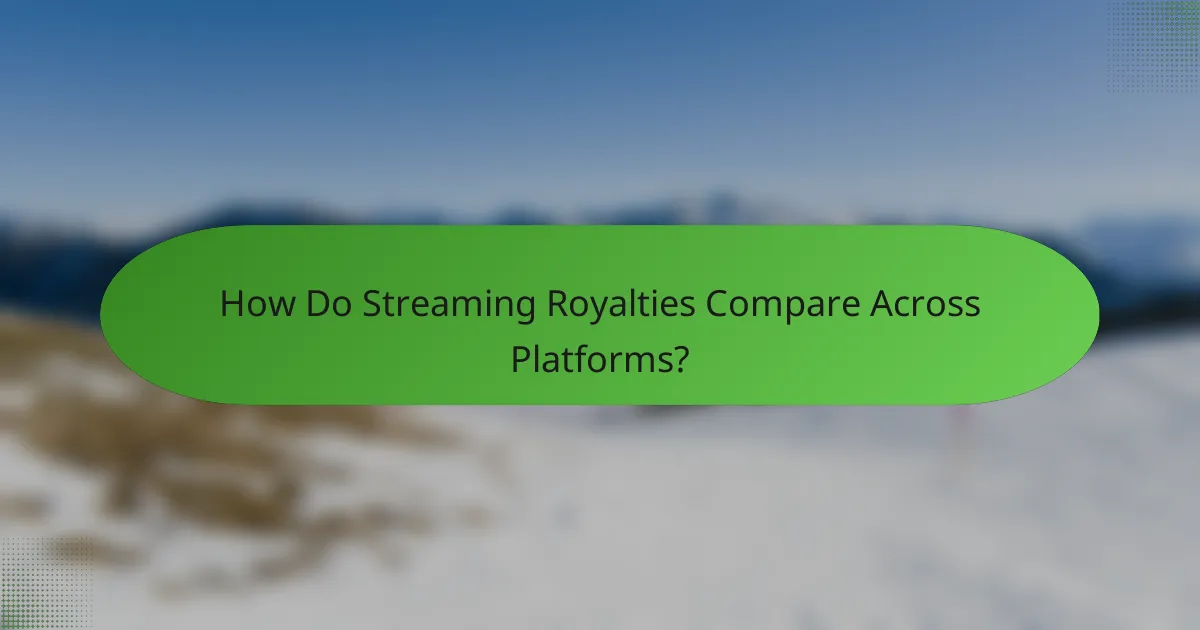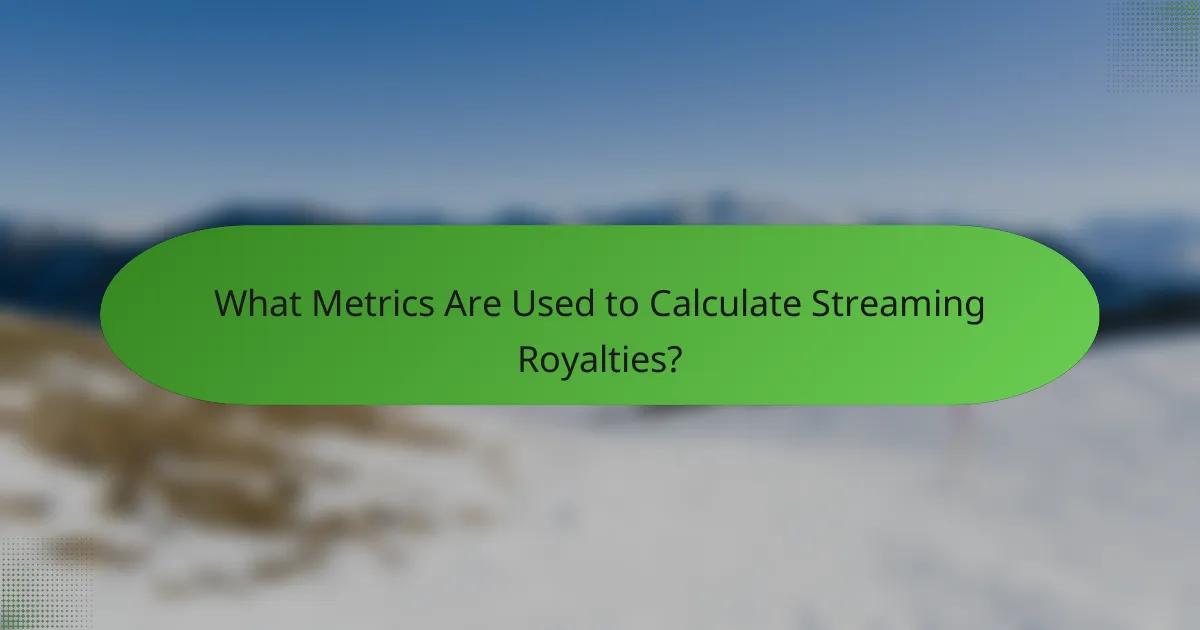Streaming royalties play a vital role in how artists and rights holders are compensated for their music on digital platforms. With varying payment structures across services, understanding these differences is essential for maximizing earnings in the competitive landscape of streaming. By analyzing key metrics related to music consumption, artists can better navigate their revenue strategies and enhance their financial outcomes.

What Are the Key Streaming Royalty Payment Structures?
The key streaming royalty payment structures include various methods by which artists and rights holders are compensated for their music on streaming platforms. Understanding these structures is crucial for artists to maximize their earnings and navigate the complexities of the digital music landscape.
Per-stream royalties
Per-stream royalties are payments made to artists based on the number of times their music is streamed. Typically, these royalties are calculated as a fraction of the total revenue generated by the streaming service, divided by the total number of streams across all tracks. This means that an artist’s earnings can vary significantly depending on their popularity and the platform’s payout rates.
For example, per-stream rates can range from a fraction of a cent to a few cents per stream, depending on the service and the artist’s contract. Artists should be aware that these rates can fluctuate and are often lower than expected, making it essential to build a substantial listener base to generate meaningful income.
Flat-rate licensing
Flat-rate licensing involves a fixed payment made to rights holders for the use of their music over a specified period. This structure is often used by streaming services that pay a set fee to license a catalog of songs, regardless of how many times those songs are streamed. This can provide artists with more predictable income compared to per-stream royalties.
However, flat-rate licensing can limit potential earnings if a song becomes extremely popular, as the payment does not scale with the number of streams. Artists should consider negotiating terms that allow for additional compensation based on performance metrics to ensure they benefit from their music’s success.
Revenue share agreements
Revenue share agreements are arrangements where streaming platforms share a percentage of their total revenue with artists and rights holders. This model can provide a more equitable distribution of earnings, as it aligns the interests of both the platform and the creators. Typically, the percentage shared can vary based on the platform and the specific agreement.
Artists should carefully review the terms of revenue share agreements to understand how their earnings will be calculated and what percentage they can expect. It’s beneficial to seek agreements that offer favorable terms, especially if the platform has a large user base or is experiencing growth.
Performance royalties
Performance royalties are earned when a song is played publicly, such as on radio, in venues, or through streaming services. These royalties are collected by performance rights organizations (PROs) and distributed to songwriters and publishers. This payment structure is crucial for artists whose music is frequently played in public settings.
To ensure they receive performance royalties, artists should register with a PRO and provide accurate information about their music. Understanding the rules and regulations governing performance royalties in their country can help artists maximize their earnings from public performances.
Mechanical royalties
Mechanical royalties are generated from the reproduction of music, such as when songs are sold or streamed. In the context of streaming, these royalties are typically paid to songwriters and publishers whenever a song is streamed on a platform. The rates for mechanical royalties can vary, but they are generally calculated based on the number of streams and the platform’s revenue.
Artists should ensure they are registered with the appropriate organizations to collect mechanical royalties. Keeping track of their music’s usage and understanding the mechanical royalty rates in their region can help artists optimize their earnings from streaming platforms.

How Do Streaming Royalties Compare Across Platforms?
Streaming royalties vary significantly across platforms, affecting how artists and rights holders earn money. Each service has its own payment structure, which can influence the overall revenue generated from music streams.
Spotify royalty rates
Spotify typically pays artists between $0.003 and $0.005 per stream, depending on various factors like the listener’s location and subscription type. This means that for every 1,000 streams, an artist might earn between $3 and $5.
It’s important for artists to understand that Spotify uses a pro-rata payment model, where total royalties are divided among all rights holders based on their share of total streams. This can lead to variability in earnings, especially for lesser-known artists.
Apple Music payment metrics
Apple Music generally offers higher royalty rates than Spotify, with payments averaging around $0.007 to $0.01 per stream. This translates to approximately $7 to $10 for every 1,000 streams, making it a more lucrative option for artists.
Apple Music operates on a user-centric payment model, meaning that the subscription fees from individual users are pooled and distributed to artists based on the number of streams they receive. This can benefit artists with dedicated fan bases.
YouTube monetization differences
YouTube’s monetization can be quite different, as artists earn money primarily through ad revenue rather than direct streaming payments. The average payout per view can range from $0.001 to $0.005, depending on factors like ad engagement and viewer demographics.
Artists can also monetize through YouTube Premium, where they receive a share of the subscription revenue based on how much their content is watched. This dual model can create a more complex revenue stream for creators.
Amazon Music royalties
Amazon Music pays artists between $0.004 and $0.008 per stream, which is competitive with other platforms. This means artists can expect to earn around $4 to $8 for every 1,000 streams, depending on various conditions.
Similar to Spotify, Amazon Music uses a pro-rata model for distributing royalties, which can lead to fluctuating earnings based on the overall number of streams across the platform. Artists should consider promoting their music to increase visibility and streams on this service.

What Metrics Are Used to Calculate Streaming Royalties?
Streaming royalties are calculated using several key metrics that reflect how music is consumed on platforms. Understanding these metrics helps artists and rights holders gauge their earnings and optimize their strategies for revenue generation.
Stream counts
Stream counts refer to the total number of times a track has been played on a streaming service. This metric is crucial, as it directly influences the royalty payments artists receive. Typically, higher stream counts lead to increased earnings, but the payout per stream can vary significantly across platforms.
For example, a song with millions of streams may earn a few thousand dollars, while another with similar counts on a different platform might yield much less. Artists should monitor their stream counts regularly to assess performance and identify popular tracks.
Market share
Market share indicates the percentage of total streams attributed to a particular artist or track within a specific time frame. This metric helps determine how an artist’s popularity compares to others in the industry. A larger market share often translates to higher royalty payments due to the competitive nature of streaming services.
For instance, if an artist captures a significant portion of the market share during a given month, they may receive a larger slice of the overall revenue pie. Understanding market share can guide artists in marketing efforts and collaborations to boost visibility.
Listener demographics
Listener demographics encompass the characteristics of the audience consuming the music, such as age, gender, and location. This information is vital for artists and labels to tailor their marketing strategies effectively. Different demographics may have varying preferences, impacting how and when music is streamed.
For example, a track that resonates well with younger audiences might perform better on platforms popular among that age group. By analyzing listener demographics, artists can target their promotions and potentially increase their streaming royalties.
Engagement rates
Engagement rates measure how actively listeners interact with a track, including actions like adding it to playlists, sharing it, or following the artist. Higher engagement rates often indicate a strong connection between the artist and their audience, which can lead to increased streaming royalties over time.
Artists should focus on building engagement through social media and live performances, as these interactions can enhance loyalty and drive more streams. Regularly assessing engagement metrics can help identify successful strategies and areas for improvement in reaching audiences.

What Factors Influence Streaming Royalty Payments in the US?
Streaming royalty payments in the US are influenced by various factors including licensing agreements, distribution deals, and artist contracts. Each of these elements plays a critical role in determining how much artists and rights holders earn from streaming platforms.
Licensing agreements
Licensing agreements are contracts between rights holders and streaming services that outline the terms of music usage. These agreements typically specify the payment structure, duration, and territorial rights, which can vary widely. For example, a major label might negotiate a higher percentage of royalties compared to an independent artist due to their leverage in the market.
Understanding the nuances of these agreements is crucial for artists. They should ensure that the terms are favorable and consider seeking legal advice to avoid unfavorable clauses that could limit their earnings.
Distribution deals
Distribution deals refer to arrangements between artists and distributors that facilitate the delivery of music to streaming platforms. These deals can affect royalty rates significantly, as distributors often take a cut of the earnings. Artists should evaluate different distribution options, as some may offer better rates or additional promotional support.
For instance, a distributor may charge a flat fee or take a percentage of royalties, which can range from 10% to 30%. Artists should weigh the benefits of wider reach against the costs involved in these agreements.
Artist contracts
Artist contracts define the relationship between the artist and their record label or management. These contracts can dictate how royalties are split, including advances and percentages from streaming revenue. It’s essential for artists to understand their contracts thoroughly, as they can vary significantly in terms of rights and obligations.
Artists should look for contracts that provide transparency in royalty calculations and ensure they retain a fair share of their streaming income. Negotiating favorable terms upfront can lead to better long-term earnings and career sustainability.

How Do International Streaming Royalties Differ?
International streaming royalties vary significantly due to differences in licensing laws, market size, and payment structures across countries. Understanding these differences is crucial for artists and rights holders to maximize their earnings from streaming platforms.
Regional licensing laws
Regional licensing laws dictate how streaming services acquire rights to distribute music and how royalties are calculated. In the European Union, for example, the EU Copyright Directive aims to standardize copyright laws, but individual countries still have their own regulations that can affect payouts.
In the United States, the Music Modernization Act has introduced new frameworks for digital royalties, but complexities remain due to the fragmented nature of copyright ownership. This can lead to variations in how much artists receive from platforms like Spotify or Apple Music.
When navigating these laws, artists should consider consulting with a music rights organization or legal expert familiar with local regulations to ensure they are receiving fair compensation for their work.
